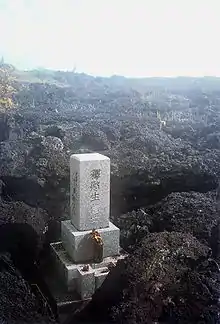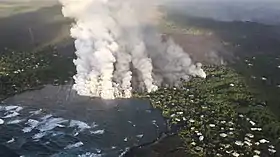Kapoho, Hawaii
Kapoho, Hawaii, is a now-uninhabited unincorporated area in Puna district, Hawaii County, Hawaii, located near the eastern tip of the island of Hawaii, in the easternmost end of the graben overlying Kīlauea's east rift zone. Originally destroyed by an eruption of Kīlauea in 1960, it was rebuilt as a community of private homes and vacation rentals. In the eruption that began in May 2018, the town was largely destroyed by lava by early June, and the bay filled in as the lava flow extended out into the ocean.

Eruption of January 1960
On January 12, 1960, residents of Kapoho experienced over 1,000 small earthquakes shaking the area. Deep cracks opened up in the street, and there are historic photos of residents inspecting the damage.[1]
The eruption began on the night of the 13th, spilling lava out in the middle of a sugar cane field just above Kapoho. Although the main flow of lava flowed into the ocean, a slow-moving offshoot crept towards the town of Kapoho. Despite frantic efforts to divert the flow with earthen barricades or to harden it by spraying water on it, on January 28 the flow entered and buried the town. Nearly 100 homes and businesses as well as a hot spring resort were destroyed. The Cape Kumukahi Light east of the town was spared and continues in operation, but the keeper's dwellings were destroyed.
Kapoho until 2018
There was no lava activity in Kapoho for close to 60 years. The natural tide pools, black sand beach, and warm hot springs transformed Kapoho into an attractive spot to live and for tourists to visit. Owing to these two factors, despite being in a very high risk lava flow hazard zone,[2] Kapoho became the most expensive area to live in Puna, with many homes costing over $1,000,000.[3][4]

2018 lower Puna eruption

The 2018 lower Puna eruption interrupted electric power to Kapoho in late May[6] and closed the main road to the rest of the island.[7] On May 30 residents were urged to evacuate.[8] On June 1, the lava flow front entered Kapoho on top of the 1960 flow and then took a turn to the south.[9] On June 2, 2018, the Green Lake (Ka Wai o Pele) was destroyed when lava flows boiled it away and completely filled the entire basin.[10][11][12] The flow entered the ocean at Kapoho Bay on June 4[13] on a half-mile-wide front.[14][15] By June 5, the lava flow had built a lava delta that extended nearly 3,700 feet (1.1 km) into the bay. Preliminary reports from Hawai'i County officials indicated that hundreds of homes in the subdivisions of Vacationland Hawaii and Kapoho Beach Lots were destroyed by the flow.[16][17] Over the next few days, the entirety of the bay was filled in with lava.[18] By the end of June, about 520 acres (2.1 km2) of new land had been created along with miles of new coastline.[19]
See also
References
- "1960 Kapoho Eruption provided lesson in Kīlauea behavior". Volcano Hazards Program. United States Geological Survey.
- Thomas L. Wright, Jon Y.F. Chun, Jean Exposo, Christina Heliker, Jon Hodge, John P. Lockwood, and Susan M. Vogt. "Map Showing Lava-Flow Hazard Zones, Island of Hawaii". pubs.usgs.gov.CS1 maint: uses authors parameter (link)
- "96778 Real Estate & Homes for Sale – realtor.com®". realtor.com®.
- site offering a now-destroyed luxury property on the Kapoho oceanfront
- "Photo and Video Chronology". Volcano Hazards Program – Kilauea. Hawaiian Volcano Observatory – U.S. Geological Survey – U.S. Department of the Interior. Retrieved 2018-06-07.
- Gebers, Samie. "Lava destroys, damages hundreds of power poles in lower Puna". Hawaii News Now.
- "East Rift Zone Eruption – 5/29/18 6:00 PM". Civil Defense Alerts and Information. County of Hawaii.
- "East Rift Zone Eruption – 5/30/18 6:00 AM". Civil Defense Alerts and Information. County of Hawaii.
- Kilauea Volcano – East Rift Zone, map updated 10:00am, June 1 (Map). United States Geological Survey. June 1, 2018. Retrieved 3 June 2018.
- Peterkin, Olivia (June 4, 2018). "Into thin air: Lava flows claim Hawaii's largest lake in a matter of hours". Hawaii News Now. Retrieved June 5, 2018.
- Comparison of satellite images on February 19 and August 6, 2018 (Planet Labs Inc.)
- Peter T Young: Ka Wai O Pele
- "Managing Director: Some residents defying voluntary evacuation order in Kapoho – Hawaii Tribune-Herald". www.hawaiitribune-herald.com.
- "County of Hawaii – Civil Defense Alerts and Information – East Rift Zone Eruption: MON, 6/4/18, 11:30AM – Update 3". www.hawaiicounty.gov.
- United States Geological Service map
- "River of lava claims hundreds more homes". Hawaii News Now. 2018-06-05. Retrieved 2018-06-05.
- Staff, HNN. "Kapoho Bay, playground for Big Islanders and many others, is lost to lava".
- https://edition.cnn.com/2018/06/06/us/hawaii-volcano-kapoho-bay/index.html
- US Geological Survey map of Kilauea East Rift Zone, June 30, 2018
- Bendure, Glenda; Friary, Ned (September 1997). "Hawaii – The Big Island". Hawaii (4th ed.). Australia: Lonely Planet. p. 322. ISBN 0-86442-489-2.
External links
| Wikimedia Commons has media related to Kapoho, Hawaii. |